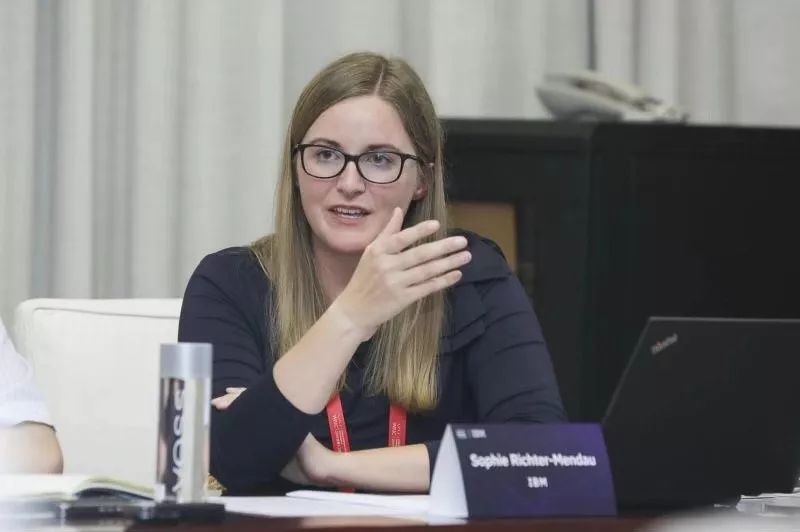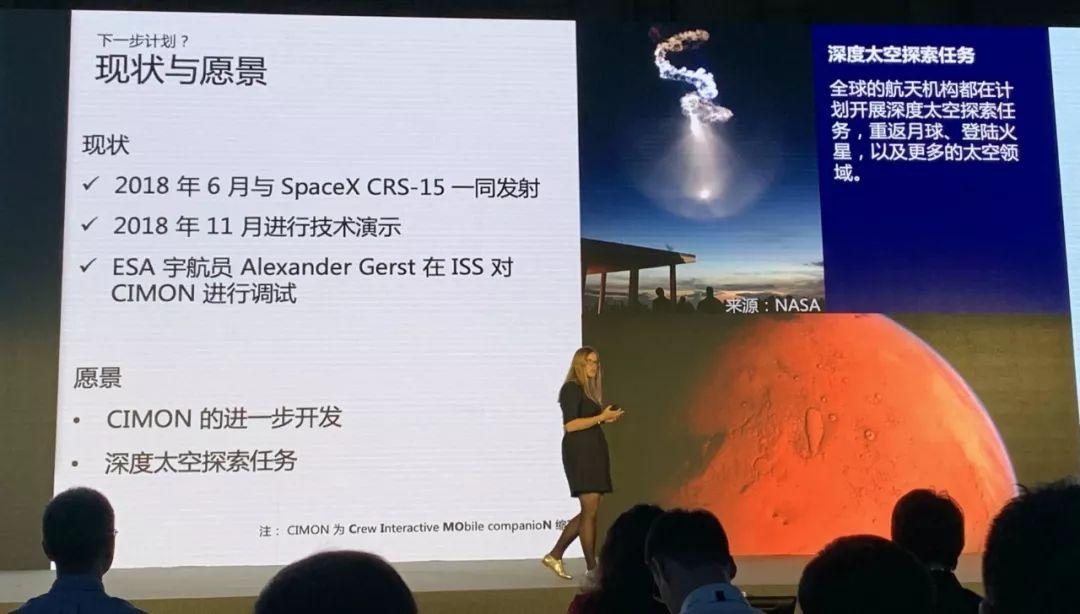This is the first “friendly” astronaut interactive mobile partner in human history with both emotional intelligence and IQ.
Editor’s note: This article is from WeChat public account “CSDN” (ID: CSDNnews), author Tang Xiaoyin.
AI has successfully entered space!
“ There are 7.7 billion people on the planet, but only 6 people live and work in outer space. (Note: The International Space Station can carry up to 6 people and carry out scientific research.) Now, there is also a robot that can not only Assisting astronauts in scientific experimental research, as well as equipment maintenance work, and psychologically, is also a companion of astronauts, providing astronauts with objective decision-making.”
At the 2019 World Artificial Intelligence Conference, the author saw Sophie Richter-Mendau, an IBM artificial intelligence consultant from Germany, who told why IBM and Airbus (Airbus) will be awarded under the German Aerospace Center (DLR). Co-developed the astronaut interactive mobile partner Project CIMON (full name Crew Interactive Mobile Companion).
This is the first “friendly” astronaut interactive mobile partner in human history with both emotional intelligence and IQ.
IBM Artificial Intelligence Advisor Sophie Richter-Mendau
01 Flying to Space: The first “Astronaut Interactive Mobile Partner” was born!
In the 400-kilometer, zero-gravity International Space Station, six astronauts are very focused on research and experimentation. The work is very compact and the experiments are very complicated.Hundreds of steps.
At the same time, for astronauts who travel in the vast universe, there are always pessimistic emotions such as loneliness, nervousness, anxiety, boredom, depression, etc. When the astronauts collapse, this will Brings huge damage and loss. The famous Russian scientist Oleg Gardenko once said in the last century a very well-known saying: “It is not medicine, but psychology that limits human exploration of space.”
As a result, in 2016, the German Aerospace Space Center, together with IBM and Airbus, formed a team of more than 50 experts, and started a process that would help astronauts experiment and provide warm communication to astronauts at any time. Research and exploration of companion intelligent robots.
Project CIMON came into being.
As the first AI robot to operate in a weightless environment, Project CIMON’s main hardware system design was developed by Airbus, using 3D printing technology, made of plastic box metal, and has a “liquid crystal” that can laugh. The face is equipped with an ultrasonic sensor that can fly freely in a zero-gravity environment. When the astronauts voiced a command to it, CIMON’s built-in fan would spin up and push it to glide gently into front of the astronauts.
And IBM has injected artificial intelligence into it, so that CIMON can not only fly autonomously, but also stop in the presence of astronauts for dialogue interaction, which integrates a large number of IBM Watson services, such as wanting to listen to aerospace In the words of the staff, Watson Speech to Text is used. The Watson Assistant is used to judge the user’s intention and the corresponding answer is given. It constitutes the brain of CIMON, and the answer is conveyed using Watson Text to Speech. At the same time, in order to make Project CIMON more expressive of some emotional content, the Watson Tone Analyzer was adopted.
Sophie Richter-Mendau said, with Siri, Cortana, Alexa and other voice assistantsThe biggest difference is that Project CIMON can be said to be an expert in aviation. “We need to train CIMON specifically so that it can work in this particular environment. For example, the environment of the space station will be noisy and we need to train CIMON. Identifying the astronaut’s vocabulary, CIMON should be able to correctly understand what they mean when the astronauts say the professional or abbreviated vocabulary they are used to.”
In this regard, based on the AI development model of “understanding-inference-learning”, IBM Watson provides project CIMON with text, speech and image processing capabilities, as well as the ability to retrieve specific information and specific discoveries, through IBM Watson speech and vision. Recognizing technology, CIMON can help astronauts complete rigorously complete complex scientific experiments and send the results back to the ground in time.
At the same time, as a friendly robot, when astronauts miss family on Earth, CIMON can recognize the facial expressions and sounds of human astronauts through the camera, listen to the microphone, understand the content, and adopt a more compassionate tone. The astronauts responded warmly and cared. As a personality designer for CIMON, Sophie and the team selected the ISTJ-type personality for CIMON, namely Introvert, Sensing, Thinking, and Judging.
Sophie said that “CIMON is not only companionship, entertainment, but also a very important identity as a technical expert. It should be a very reliable partner to help astronauts find detailed information, through the process, and not to miss information. When it comes to making decisions, it needs to be a logically clear reasoner, not an intuition.”
04 From development to successful launch, it only takes two years!
In June 2018, CIMON took off on the Space X Falcon 9 rocket and made its first space interaction in November, and CIMON is becoming smarter. IBM and Airbus consider this in two dimensions:
-
Project CIMON can assist astronauts in completing an experimental task, ie, the number of tasks that have been started, completed, or closedAs a hard indicator;
-
Based on the user/astronaut’s acceptance and satisfaction with the robot.
Now, CIMON is not only able to understand the technical details of the space station, but also proficient in various technical terms in space, and naturally communicate and interact with astronauts, and has become a “powerful assistant” for astronauts. Moreover, through the real interactive dialogue, while improving the efficiency of the space station, it also greatly reduces the life and work pressure of the astronauts away from the earth in space.
When humans first landed on the moon 50 years ago, 4,000 IBM engineers, scientists, and researchers wrote five million lines of code together. At that time, it was difficult to manage the development of Apollo’s guidance program. For most of the business, Fred Martin, 85, said: “Software has saved (Apollo) mission.”
Since CIMON took only two years from project to launch, it was not efficient, and it faced many challenges in its development.
Sophie said: “In the field of aviation, the creation of such a robot and its successful launch into space, the two-year period is very short. On the one hand, we need to simulate the space environment on Earth to test, on the other hand, We also face a very big problem, that is, the user group is very small, not as many astronauts can let you test the user acceptance. But this test is crucial because AI needs a lot of data. Training can continue to be iteratively getting better and better. Without an astronaut to help with testing, it is difficult to make this system perfect.”
03 How to train smart and warm space AI with extremely little data?
As a dedicated AI, the amount of data that CIMON can use for training is very scarce, and deep learning itself is very dependent on data. So, in the case of astronauts’ own limited data, how to get more Data to learn? For this problem, Sophie told CSDN (ID:CSDNnews): “The data we obtained from the real experiment is the most beneficial. At the same time, we are also collecting simulation data through the ground laboratory for analysis. This is a feasible direction.
At the same time, Sophie also talked about a crucial issue, and that is latency. The various AI functions implemented by Project CIMON are based on the IBM Cloud’s real-time connection via the data link of the satellite network, which means that each time you issue a command to CIMON, the command needs to go through the “satellite-terrestrial satellite receiving station-IBM cloud data. The steps of the center – returning to space, plus the processing time on the earth, resulting inThere is a 2 second delay in talking to CIMON in space.
In this regard, Sophie talked about the solution being tried: “The more parts that are run locally (in space), the faster the speed and the shorter the delay, but the problem is that in terms of edge computing How much power we can do at the space station remains to be explored. Currently, we are trying to further compress the required computing power through the convergence of Watson Anywhere and Cloud Pak for Data.”
04 Maybe one day, AI can also detect on Mars!
According to Engadget, CIMON, which has left the Earth to fly in space for more than 400 days, officially returned to Earth in August this year. The new CIMON is expected to serve in the International Space Station in December, over the past 400 days. CIMON and the astronauts have done a lot of very difficult tasks together.
Sophie shared with us at the scene: “When the astronauts first saw CIMON, there was still some doubt. But after more and more interactions in the space station, our astronauts felt this technology. Very excited and happy. CIMON is a first step in the development of AI’s deep space. Humans have always been curious. We hope to make better use of technologies like AI and use AI assistants.”
In the future, IBM and Airbus are continuing to develop Project CIMON for new applications, such as target detection, and let CIMON participate in outer space exploration missions such as lunar exploration and Mars exploration.





